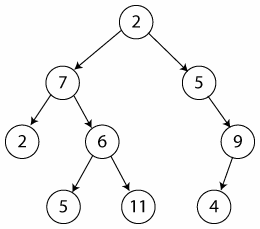Summary: Lowest Common Ancestor in a Binary Tree & Shortest Path In a Binary Tree
转自:Pavel's Blog
 |
public static Node lowestCommonAncestor(Node root, Node a, Node b) {
if (root == null) {
return null;
}
if (root.equals(a) || root.equals(b)) {
// if at least one matched, no need to continue
// this is the LCA for this root
return root;
}
Node l = lowestCommonAncestor(root.left, a, b);
Node r = lowestCommonAncestor(root.right, a, b);
if (l != null && r != null) {
return root; // nodes are each on a seaparate branch
}
// either one node is on one branch,
// or none was found in any of the branches
return l != null ? l : r;
}
For the node used we will use the following class:
public class Node {
public int data;
public Node right;
public Node left;
public Node(int data) {
this.data = data;
}
}
这个问题再follow up一下,就是要找到shortest path in a binary tree between two nodes
public class Solution {
public static List<Node> shortestPath(Node root, Node a, Node b) {
ArrayList<Node> path1 = new ArrayList<Node>();
ArrayList<Node> path2 = new ArrayList<Node>();
Node LCA = lowestCommonAncestor(root, a, b);
helper(LCA.left, a, b, path1, new ArrayList<Node>());
helper(LCA.right, a, b, path2, new ArrayList<Node>());
Collections.reverse(path1);
path1.add(LCA);
path1.addAll(new ArrayList<Node>(path2));
return path1;
}
public void helper(Node root, Node a, Node b, ArrayList<Node> outpath, ArrayList<Node> temp) {
if (root == null) return;
temp.add(root);
if (root == a || root == b) {
outpath = new ArrayList<Node>(temp);
return;
}
helper(root.left, a, b, outpath, temp);
helper(root.right, a, b, outpath, temp);
temp.remove(temp.size()-1);
}
}
别人的Stack做法,未深究 他说First stack is not really needed, a simple list would do - I just like symmetry.
public static <V> void shortestpath(
Node<V> root, Node<V> a, Node<V> b,
Stack<Node<V>> outputPath) {
if (root == null) {
return;
}
if (root.data.equals(a.data) || root.data.equals(b.data)) {
outputPath.push(root);
return;
} shortestpath(root.left, a, b, outputPath);
shortestpath(root.right, a, b, outputPath); outputPath.push(root);
} public static List<Node> shortestPath(Node root, Node a, Node b) {
Stack<Node> path1 = new Stack<>();
Stack<Node> path2 = new Stack<>(); Node lca = lowestCommonAncestor(root, a, b); // This is to handle the case where one of the nodes IS the LCA
Node r = lca.equals(a) ? a : (lca.equals(b) ? b : lca); shortestpath(r.left, a, b, path1);
shortestpath(r.right, a, b, path2); path1.push(r);
// invert the second path
while (!path2.isEmpty()) {
path1.push(path2.pop());
}
return path1;
}
Summary: Lowest Common Ancestor in a Binary Tree & Shortest Path In a Binary Tree的更多相关文章
- Range Minimum Query and Lowest Common Ancestor
作者:danielp 出处:http://community.topcoder.com/tc?module=Static&d1=tutorials&d2=lowestCommonAnc ...
- A1143. Lowest Common Ancestor
The lowest common ancestor (LCA) of two nodes U and V in a tree is the deepest node that has both U ...
- PAT A1143 Lowest Common Ancestor (30 分)——二叉搜索树,lca
The lowest common ancestor (LCA) of two nodes U and V in a tree is the deepest node that has both U ...
- 1143 Lowest Common Ancestor
The lowest common ancestor (LCA) of two nodes U and V in a tree is the deepest node that has both U ...
- PAT 甲级 1143 Lowest Common Ancestor
https://pintia.cn/problem-sets/994805342720868352/problems/994805343727501312 The lowest common ance ...
- PAT 1143 Lowest Common Ancestor[难][BST性质]
1143 Lowest Common Ancestor(30 分) The lowest common ancestor (LCA) of two nodes U and V in a tree is ...
- [PAT] 1143 Lowest Common Ancestor(30 分)
1143 Lowest Common Ancestor(30 分)The lowest common ancestor (LCA) of two nodes U and V in a tree is ...
- 1143. Lowest Common Ancestor (30)
The lowest common ancestor (LCA) of two nodes U and V in a tree is the deepest node that has both U ...
- PAT 1143 Lowest Common Ancestor
The lowest common ancestor (LCA) of two nodes U and V in a tree is the deepest node that has both U ...
随机推荐
- 整理一系列优秀的Android开发源码
转:http://www.cnblogs.com/feifei1010/archive/2012/09/12/2681527.html 游戏类: 一.15个Android游戏源码(是以andengin ...
- Android 本地tomcat服务器接收处理手机上传的数据之案例演示
上一篇:Android 本地tomcat服务器接收处理手机上传的数据之环境搭建 本篇基于上一篇搭建的服务器端环境,具体介绍Android真机上传数据到tomcat服务器的交互过程 场景:A ...
- 使用virtualbox 配置 linux host-only虚拟主机连接外网(转载)
host-only 下的虚拟机之间可以互相访问,虚拟机和宿主机可以互相访问,但是虚拟机不能访问外网. 需要设置: 1.宿主机设置 先对宿主机(windows机器,我这里是win7系统)进行相关配置. ...
- wireshark和RawCap跟踪并解决中文乱码问题
一.问题概述 说下程序的架构. 有个后台管理系统A,在页面修改数据后,会用httpClient发http请求给系统B: 系统B做了异步机制,收到A发的请求后,将数据封装为Mq消息发给RabbitMq, ...
- 为Docker容器中运行的gitlab添加ssh的一些问题记录
最近做的一个东西,是将gitlab10.x的汉化版本,从源码编译(在源码中自己定制一些东西),然后制作成Docker镜像,作为Docker容器来运行 在启用容器中的gitlab的ssh的时候,遇到了一 ...
- C# 读取xml时,遇到xmlns的问题
1.读取xml的时候,由于xml里有xmlns的属性,导致了读xml无法正常读取.通过网上搜索,发现需要先注册命名空间. xmlns是XML Namespaces的缩写,中文名称是XML(标准通用标 ...
- 检查mono兼容性的工具MOAM
mono的迁移工具,可以帮助我们从windows平台迁移到Linux平台,可以用来检测特定的.net的dll或exe程序对mono的兼容性,并能够给出不兼容的方法 项目地址 MoMA 项目介绍 MoM ...
- 【CF908G】New Year and Original Order 数位DP
[CF908G]New Year and Original Order 题意:令S(i)表示将i中所有数位上的数拿出来,从小到大排序后组成一个新的数的值.如S(50394)=3459.求$\sum\l ...
- JPEG图片扩展信息读取与修改
extends:http://www.2cto.com/kf/201405/303813.html 读写均是键值对的方式,需要注意的是值的类型需要严格按照api定义格式. 支持读写节点为: 1.TAG ...
- spring boot 通过Maven + tomcat 自动化部署
使用maven创建的springboot项目,默认是jar包,springboot还有自己带的tomcat. 现在为了简单实现本地自动发布项目到服务器,需要通过发布war包的形式,通过maven将项目 ...
